Comparison of Curing Conditions on Physical Properties, Mechanical Strength Development, and Pore Structures of Phosphogypsum-Based Cold-Bonded Aggregates
Abstract
:1. Introduction
2. Raw Materials and Methods
2.1. Raw Materials
2.2. Mix Proportion and Preparation Process
- Seeding. Take 200 g of the mixed powder and pour it into the uniformly rotating disk granulator; use the atomizing spray can to spray a small amount of water to make the powder in the disk slightly wet. After all the powder is wet, continue to add the power mixture; the wet powder in the disk will agglomerate to form the seed pellets. Alternate steps of adding powder and sprinkling water. When the seed pellets are still fragile, a rolling and curtain-dropping movement will make them constantly collide with the force squeeze to become dense.
- Size enlargement. After the formation of seeds, a small amount of atomized water is sprayed into the disk to moisten the surface of these microspheres. Then, a small amount of powder is evenly sprinkled into the disk to make the newly added powder evenly adhere to the surface of seeds, and the powder is fused with the aggregate microspheres under the effect of water adhesion. Then, under the action of gravity, the pellets fall along the arc of the disk surface to the bottom of the pelletizing disk. During the movement, the pellets are continuously compacted from the inside out by the compression of the inner wall of the pelletizing disk and by their own gravity. The process is repeated several times until the pellet diameter increases to 8 mm. The size is controlled by sieving.
2.3. Testing Methods
2.4. Microstructure Testing Scheme
2.5. Phosphorus Leaching Test
2.5.1. Static Leaching Test
2.5.2. Acetic Acid Leaching Test
3. Results and Discussion
3.1. Physical Properties
3.1.1. Bulk Density
3.1.2. Water Absorption
3.2. Mechanical Properties
3.2.1. Cylinder Compressive Strength and Softening Coefficient
3.2.2. Single Aggregate Strength
3.3. Hydration Products and Microstructure Analysis
3.3.1. Hydration Products
3.3.2. Specific Surface Area and Pore Size Distribution
3.4. Leaching Behavior of Phosphorus
4. Conclusions
Author Contributions
Funding
Institutional Review Board Statement
Informed Consent Statement
Data Availability Statement
Conflicts of Interest
References
- Ouyang, G.; Sun, T.; Yu, Z.; Xu, F.; Bai, J.; Xu, D. Investigation on Macroscopic Properties, Leachability and Microstructures of Surface Reinforced Phosphogypsum-Based Cold-Bonded Aggregates. J. Build. Eng. 2023, 69, 106305. [Google Scholar] [CrossRef]
- Ding, C.; Sun, T.; Shui, Z.; Xie, Y.; Ye, Z. Physical Properties, Strength, and Impurities Stability of Phosphogypsum-Based Cold-Bonded Aggregates. Constr. Build. Mater. 2022, 331, 127307. [Google Scholar] [CrossRef]
- Murali, G.; Azab, M. Recent Research in Utilization of Phosphogypsum as Building Materials: Review. J. Mater. Res. Technol. 2023, 25, 960–987. [Google Scholar] [CrossRef]
- Riazanov, V.V. Environmental Problems of Phosphogypsum Utilization. Key Eng. Mater. 2020, 864, 108–114. [Google Scholar] [CrossRef]
- Qin, X.; Cao, Y.; Guan, H.; Hu, Q.; Liu, Z.; Xu, J.; Hu, B.; Zhang, Z.; Luo, R. Resource Utilization and Development of Phosphogypsum-Based Materials in Civil Engineering. J. Clean. Prod. 2023, 387, 135858. [Google Scholar] [CrossRef]
- Sun, T.; Xu, D.; Ouyang, G.; Wang, Z.; Ye, Z. Mechanical Properties and Environmental Implications of Excess-Sulfate Cement Concrete with Phosphogypsum-Based Cold-Bonded Fine Aggregates. J. Build. Eng. 2024, 95, 110008. [Google Scholar] [CrossRef]
- Sun, T.; Li, W.; Xu, F.; Yu, Z.; Wang, Z.; Ouyang, G.; Xu, D. A New Eco-Friendly Concrete Made of High Content Phosphogypsum Based Aggregates and Binder: Mechanical Properties and Environmental Benefits. J. Clean. Prod. 2023, 400, 136555. [Google Scholar] [CrossRef]
- Li, H.; Xu, F.; Li, B.; Sun, T.; Huang, X.; Zhu, J.; Peng, C.; Lin, J.; Chen, Z. Investigation on Mechanical Properties of Excess-Sulfate Phosphogypsum Slag Cement: From Experiments to Molecular Dynamics Simulation. Constr. Build. Mater. 2022, 315, 125685. [Google Scholar] [CrossRef]
- Huang, Y.; Lin, Z. Investigation on Phosphogypsum–Steel Slag–Granulated Blast-Furnace Slag–Limestone Cement. Constr. Build. Mater. 2010, 24, 1296–1301. [Google Scholar] [CrossRef]
- Chen, W.; Luo, Z.; Sun, T.; Tang, P.; Jin, D. Utilization of High-Volume Phosphogypsum in Artificial Aggregate by Compaction Granulation: Effects of Muck on Physical Properties, Strength and Leaching Stability. J. Sustain. Cem.-Based Mater. 2022, 12, 951–961. [Google Scholar] [CrossRef]
- Tajra, F.; Elrahman, M.A.; Stephan, D. The Production and Properties of Cold-Bonded Aggregate and Its Applications in Concrete: A Review. Constr. Build. Mater. 2019, 225, 29–43. [Google Scholar] [CrossRef]
- Gruskovnjak, A.; Lothenbach, B.; Winnefeld, F.; Figi, R.; Ko, S.-C.; Adler, M.; Mäder, U. Hydration Mechanisms of Super Sulphated Slag Cement. Cem. Concr. Res. 2008, 38, 983–992. [Google Scholar] [CrossRef]
- Pinto, S.R.; Angulski da Luz, C.; Munhoz, G.S.; Medeiros-Junior, R.A. Durability of Phosphogypsum-Based Supersulfated Cement Mortar against External Attack by Sodium and Magnesium Sulfate. Cem. Concr. Res. 2020, 136, 106172. [Google Scholar] [CrossRef]
- Li, L.; Wang, R.; Zhang, S. Effect of Curing Temperature and Relative Humidity on the Hydrates and Porosity of Calcium Sulfoaluminate Cement. Constr. Build. Mater. 2019, 213, 627–636. [Google Scholar] [CrossRef]
- Xie, Y.; Sun, T.; Shui, Z.; Ding, C.; Li, W. The Impact of Carbonation at Different CO2 Concentrations on the Microstructure of Phosphogypsum-Based Supersulfated Cement Paste. Constr. Build. Mater. 2022, 340, 127823. [Google Scholar] [CrossRef]
- Sun, T.; Xiao, X.; Ouyang, G.; Li, W.; Tang, P.; Wang, Z. Utilization of Waterglass Coatings to Improve the Carbonization Resistance of Excess-Sulphate Phosphogypsum Slag Plastering Mortar. Constr. Build. Mater. 2023, 408, 133644. [Google Scholar] [CrossRef]
- Wang, Z.; Shui, Z.; Sun, T.; Li, H.; Chi, H.; Ouyang, G.; Li, Z.; Tang, P. Effect of MgO and Superfine Slag Modification on the Carbonation Resistance of Phosphogypsum-Based Cementitious Materials: Based on Hydration Enhancement and Phase Evolution Regulation. Constr. Build. Mater. 2024, 415, 134914. [Google Scholar] [CrossRef]
- Singh Rajput, B.; Pratap Singh Rajawat, S.; Jain, G. Effect of Curing Conditions on the Compressive Strength of Fly Ash-Based Geopolymer Concrete. Mater. Today Proc. 2023. [Google Scholar] [CrossRef]
- Manikandan, R.; Ramamurthy, K. Effect of Curing Method on Characteristics of Cold Bonded Fly Ash Aggregates. Cem. Concr. Compos. 2008, 30, 848–853. [Google Scholar] [CrossRef]
- Shafiq, N.; Cabrera, J.G. Effects of Initial Curing Condition on the Fluid Transport Properties in OPC and Fly Ash Blended Cement Concrete. Cem. Concr. Compos. 2004, 26, 381–387. [Google Scholar] [CrossRef]
- Huang, F.; Hu, Z.; Li, H.; Wang, Y.; Liu, J. Deformation Mechanisms of Cement Paste with Ultra-Low Water-to-Cement Ratios under Different Curing Conditions at Early Ages. Constr. Build. Mater. 2023, 364, 129951. [Google Scholar] [CrossRef]
- Chaiyaput, S.; Arwaedo, N.; Kingnoi, N.; Nghia-Nguyen, T.; Ayawanna, J. Effect of Curing Conditions on the Strength of Soil Cement. Case Stud. Constr. Mater. 2022, 16, e01082. [Google Scholar] [CrossRef]
- Yu, P.; Kirkpatrick, R.J.; Poe, B.; McMillan, P.F.; Cong, X. Structure of calcium silicate hydrate (C-S-H): Near-, Mid-, and Far-infrared spectroscopy. J. Am. Ceram. Soc. 1999, 82, 742–748. [Google Scholar] [CrossRef]
- Lura, P.; Winnefeld, F.; Fang, X. A Simple Method for Determining the Total Amount of Physically and Chemically Bound Water of Different Cements. J. Therm. Anal. Calorim. 2017, 130, 653–660. [Google Scholar] [CrossRef]
- Taylor, H.F.W. Cement Chemistry, 2nd ed.; Thomas Telford Publishing: London, UK, 1997. [Google Scholar]
- Li, K.; Luo, M.; Pang, X.; Zeng, Q. Pore Structure of Cement-Based Materiial under Different Curing Conditions. J. Build. Mater. 2014, 17, 187–192+227. [Google Scholar]
- Tajra, F.; Abd Elrahman, M.; Lehmann, C.; Stephan, D. Properties of Lightweight Concrete Made with Core-Shell Structured Lightweight Aggregate. Constr. Build. Mater. 2019, 205, 39–51. [Google Scholar] [CrossRef]
- Yin, W.C.Y.P. Upcycling of Phosphogypsum as Anhydrite Plaster: The Positive Effect of Soluble Phosphorus Impurities. Constr. Build. Mater. 2023, 372, 130824. [Google Scholar] [CrossRef]
- Tang, P.; Xuan, D.; Cheng, H.W.; Poon, C.S.; Tsang, D.C.W. Use of CO2 Curing to Enhance the Properties of Cold Bonded Lightweight Aggregates (CBLAs) Produced with Concrete Slurry Waste (CSW) and Fine Incineration Bottom Ash (IBA). J. Hazard. Mater. 2020, 381, 120951. [Google Scholar] [CrossRef]
- GB/T 18046-2017; Granulated Blast Furnace Slag Used for Cement Mortar and Concrete. National Standardization Technical Committee Cement: Beijing, China, 2017.
- B/T 17431.1-2010; Lightweight Aggregates and Its Test Methods-Part 1: Lightweight Aggregates. China Building Materials Federation: Beijing, China, 2010.
- GB/T 17431.2-2010; Lightweight Aggregates and Its Test Methods-Part 2: Test Methods for Lightweight Aggregates. China Building Materials Federation: Beijing, China, 2010.
- Gao, W.; Jian, S.; Li, X.; Tan, H.; Li, B.; Lv, Y.; Huang, J. The Use of Contaminated Soil and Lithium Slag for the Production of Sustainable Lightweight Aggregate. J. Clean. Prod. 2022, 348, 131361. [Google Scholar] [CrossRef]
- Liu, J.; Li, P.; Sun, Z.; Lu, Z.; Du, Z.; Liang, H.; Lu, D. A New Method for Analysis of Dual Pore Size Distributions in Shale Using Nitrogen Adsorption Measurements. Fuel 2017, 210, 446–454. [Google Scholar] [CrossRef]
- Choma, J.; Jagiello, J.; Jaroniec, M. Assessing the Contribution of Micropores and Mesopores from Nitrogen Adsorption on Nanoporous Carbons: Application to Pore Size Analysis. Carbon 2021, 183, 150–157. [Google Scholar] [CrossRef]
- Zhang, B.; Chen, Y. Particle Size Effect on Pore Structure Characteristics of Lignite Determined via Low-Temperature Nitrogen Adsorption. J. Nat. Gas Sci. Eng. 2020, 84, 103633. [Google Scholar] [CrossRef]
- HJ 557-2010; Solid Waste-extraction Procedure for Leaching Toxicity-horizontal Vibration Method. PRC Ministry of Ecology and Environment: Beijing, China, 2010.
- Thomas, J.J.; Hsieh, J.; Jennings, H.M. Effect of Carbonation on the Nitrogen BET Surface Area of Hardened Portland Cement Paste. Adv. Cem. Based Mater. 1996, 3, 76–80. [Google Scholar] [CrossRef]
- Xu, Z.; Zhang, Z.; Huang, J.; Yu, K.; Zhong, G.; Chen, F.; Chen, X.; Yang, W.; Wang, Y. Effects of Temperature, Humidity and CO2 Concentration on Carbonation of Cement-Based Materials: A Review. Constr. Build. Mater. 2022, 346, 128399. [Google Scholar] [CrossRef]
- Narattha, C.; Chaipanich, A. Phase Characterizations, Physical Properties and Strength of Environment-Friendly Cold-Bonded Fly Ash Lightweight Aggregates. J. Clean. Prod. 2018, 171, 1094–1100. [Google Scholar] [CrossRef]
- Liu, G.; Guan, B.; Liang, Y.; Xing, H.; Huang, A.; Qin, J. Preparation of Phosphogypsum (PG) Based Artificial Aggregate and Its Application in the Asphalt Mixture. Constr. Build. Mater. 2022, 356, 129218. [Google Scholar] [CrossRef]
- Nedeljković, M.; Ghiassi, B.; van der Laan, S.; Li, Z.; Ye, G. Effect of Curing Conditions on the Pore Solution and Carbonation Resistance of Alkali-Activated Fly Ash and Slag Pastes. Cem. Concr. Res. 2019, 116, 146–158. [Google Scholar] [CrossRef]
- Li, Y.; Liu, W.; Xing, F.; Wang, S.; Tang, L.; Lin, S.; Dong, Z. Carbonation of the Synthetic Calcium Silicate Hydrate (C-S-H) under Different Concentrations of CO2: Chemical Phases Analysis and Kinetics. J. CO2 Util. 2020, 35, 303–313. [Google Scholar] [CrossRef]
- Morandeau, A.; Thiéry, M.; Dangla, P. Investigation of the Carbonation Mechanism of CH and C-S-H in Terms of Kinetics, Microstructure Changes and Moisture Properties. Cem. Concr. Res. 2014, 56, 153–170. [Google Scholar] [CrossRef]
- Zhang, Y.; Feng, H.; Shah, S.Y.; Xin, H. Effect of Shrinkage-Mitigating Additive and Curing Condition on Flexural and Fracture Behavior of Ultra-High-Performance Concrete (UHPC) Unnotched Beam. Constr. Build. Mater. 2024, 445, 137890. [Google Scholar] [CrossRef]
- Liu, C.; Wu, H.; Li, Z.; Shi, H.; Ye, G. Effect of Curing Condition on Mechanical Properties and Durability of Alkali-Activated Slag Mortar. Constr. Build. Mater. 2024, 439, 137376. [Google Scholar] [CrossRef]
- Wu, M.; Shen, W.; Xiong, X.; Zhao, L.; Yu, Z.; Sun, H.; Xu, G.; Zhao, Q.; Wang, G.; Zhang, W. Effects of the Phosphogypsum on the Hydration and Microstructure of Alkali Activated Slag Pastes. Constr. Build. Mater. 2023, 368, 130391. [Google Scholar] [CrossRef]
- Deboucha, W.; Leklou, N.; Khelidj, A.; Oudjit, M.N. Hydration Development of Mineral Additives Blended Cement Using Thermogravimetric Analysis (TGA): Methodology of Calculating the Degree of Hydration. Constr. Build. Mater. 2017, 146, 687–701. [Google Scholar] [CrossRef]
- Roosz, C.; Gaboreau, S.; Grangeon, S.; Prêt, D.; Montouillout, V.; Maubec, N.; Ory, S.; Blanc, P.; Vieillard, P.; Henocq, P. Distribution of Water in Synthetic Calcium Silicate Hydrates. Langmuir 2016, 32, 6794–6805. [Google Scholar] [CrossRef]
- Wang, Z.; Shui, Z.; Li, Z.; Sun, T.; Ye, Z. Hydration Characterization of Mg2+ Blended Excess-Sulphate Phosphogypsum Slag Cement System during Early Age. Constr. Build. Mater. 2022, 345, 128191. [Google Scholar] [CrossRef]
- Powers, T.C. Structure and Physical Properties of Hardened Portland Cement Paste. J. Am. Ceram. Soc. 1958, 41, 1–6. [Google Scholar] [CrossRef]
- García Lodeiro, I.; Macphee, D.E.; Palomo, A.; Fernández-Jiménez, A. Effect of Alkalis on Fresh C–S–H Gels. FTIR Analysis. Cem. Concr. Res. 2009, 39, 147–153. [Google Scholar] [CrossRef]
- Mollah, M.Y.A.; Yu, W.; Schennach, R.; Cocke, D.L. A Fourier Transform Infrared Spectroscopic Investigation of the Early Hydration of Portland Cement and the Influence of Sodium Lignosulfonate. Cem. Concr. Res. 2000, 30, 267–273. [Google Scholar] [CrossRef]
- Bensalah, H.; Bekheet, M.F.; Alami Younssi, S.; Ouammou, M.; Gurlo, A. Hydrothermal Synthesis of Nanocrystalline Hydroxyapatite from Phosphogypsum Waste. J. Environ. Chem. Eng. 2018, 6, 1347–1352. [Google Scholar] [CrossRef]
- Thiery, M.; Villain, G.; Dangla, P.; Platret, G. Investigation of the Carbonation Front Shape on Cementitious Materials: Effects of the Chemical Kinetics. Cem. Concr. Res. 2007, 37, 1047–1058. [Google Scholar] [CrossRef]
- Choudhary, H.K.; Anupama, A.V.; Kumar, R.; Panzi, M.E.; Matteppanavar, S.; Sherikar, B.N.; Sahoo, B. Observation of Phase Transformations in Cement during Hydration. Constr. Build. Mater. 2015, 101, 122–129. [Google Scholar] [CrossRef]
- García-Lodeiro, I.; Fernández-Jiménez, A.; Blanco, M.T.; Palomo, A. FTIR Study of the Sol-Gel Synthesis of Cementitious Gels: C-S-H and N-A-S-H. J. Sol-Gel Sci. Technol. 2008, 45, 63–72. [Google Scholar] [CrossRef]
- Lo, Y.; Lee, H.M. Curing Effects on Carbonation of Concrete Using a Phenolphthalein Indicator and Fourier-Transform Infrared Spectroscopy. Build. Environ. 2002, 37, 507–514. [Google Scholar] [CrossRef]
- Gijbels, K.; Pontikes, Y.; Samyn, P.; Schreurs, S.; Schroeyers, W. Effect of NaOH Content on Hydration, Mineralogy, Porosity and Strength in Alkali/Sulfate-Activated Binders from Ground Granulated Blast Furnace Slag and Phosphogypsum. Cem. Concr. Res. 2020, 132, 106054. [Google Scholar] [CrossRef]
- Perkins, R.B.; Palmer, C.D. Solubility of Ettringite (Ca6[Al(OH)6]2(SO4)3 · 26H2O) at 5–75 °C. Geochim. Cosmochim. Acta 1999, 63, 1969–1980. [Google Scholar] [CrossRef]
- Yousuf, M.; Mollah, A.; Hess, T.R.; Tsai, Y.-N.; Cocke, D.L. An FTIR and XPS Investigations of the Effects of Carbonation on the Solidification/Stabilization of Cement Based Systems-Portland Type V with Zinc. Cem. Concr. Res. 1993, 23, 773–784. [Google Scholar] [CrossRef]
- Barzgar, S.; Tarik, M.; Ludwig, C.; Lothenbach, B. The Effect of Equilibration Time on Al Uptake in C-S-H. Cem. Concr. Res. 2021, 144, 106438. [Google Scholar] [CrossRef]
- Kapeluszna, E.; Kotwica, Ł.; Różycka, A.; Gołek, Ł. Incorporation of Al in C-A-S-H Gels with Various Ca/Si and Al/Si Ratio: Microstructural and Structural Characteristics with DTA/TG, XRD, FTIR and TEM Analysis. Constr. Build. Mater. 2017, 155, 643–653. [Google Scholar] [CrossRef]
- Wang, Z.; Shui, Z.; Sun, T.; Li, X.; Zhang, M. Recycling Utilization of Phosphogypsum in Eco Excess-Sulphate Cement: Synergistic Effects of Metakaolin and Slag Additives on Hydration, Strength and Microstructure. J. Clean. Prod. 2022, 358, 131901. [Google Scholar] [CrossRef]
- Dong, E.; Fu, S.; Wu, C.; Lv, W.; Liu, X.; Zhang, L.; Feng, Y.; Shui, Z.; Yu, R. Value-Added Utilization of Phosphogypsum Industrial by-Products in Producing Green Ultra-High Performance Concrete: Detailed Reaction Kinetics and Microstructure Evolution Mechanism. Constr. Build. Mater. 2023, 389, 131726. [Google Scholar] [CrossRef]
- Bai, S.; Guan, X.; Li, H.; Ou, J. Effect of the Specific Surface Area of Nano-Silica Particle on the Properties of Cement Paste. Powder Technol. 2021, 392, 680–689. [Google Scholar] [CrossRef]
- Kaufmann, J. Pore Space Analysis of Cement-Based Materials by Combined Nitrogen Sorption—Wood’s Metal Impregnation and Multi-Cycle Mercury Intrusion. Cem. Concr. Compos. 2010, 32, 514–522. [Google Scholar] [CrossRef]
- Zhu, X.; He, B.; Xie, M.; Zhang, Y.; Jiang, Z. A Comprehensive Nitrogen Adsorption Measurement on the Pore Structure of Calcium-Silicate-Hydrate Subjected to Cryogenic Attack. Measurement 2021, 184, 109941. [Google Scholar] [CrossRef]
- Seigneur, N.; De Windt, L.; Poyet, S.; Socié, A.; Dauzères, A. Modelling of the Evolving Contributions of Gas Transport, Cracks and Chemical Kinetics during Atmospheric Carbonation of Hydrated C3S and C-S-H Pastes. Cem. Concr. Res. 2022, 160, 106906. [Google Scholar] [CrossRef]
- Meskini, S.; Mechnou, I.; Benmansour, M.; Remmal, T.; Samdi, A. Environmental Investigation on the Use of a Phosphogypsum-Based Road Material: Radiological and Leaching Assessment. J. Environ. Manag. 2023, 345, 118597. [Google Scholar] [CrossRef]
- Liu, S.; Fang, P.; Ren, J.; Li, S. Application of Lime Neutralised Phosphogypsum in Supersulfated Cement. J. Clean. Prod. 2020, 272, 122660. [Google Scholar] [CrossRef]
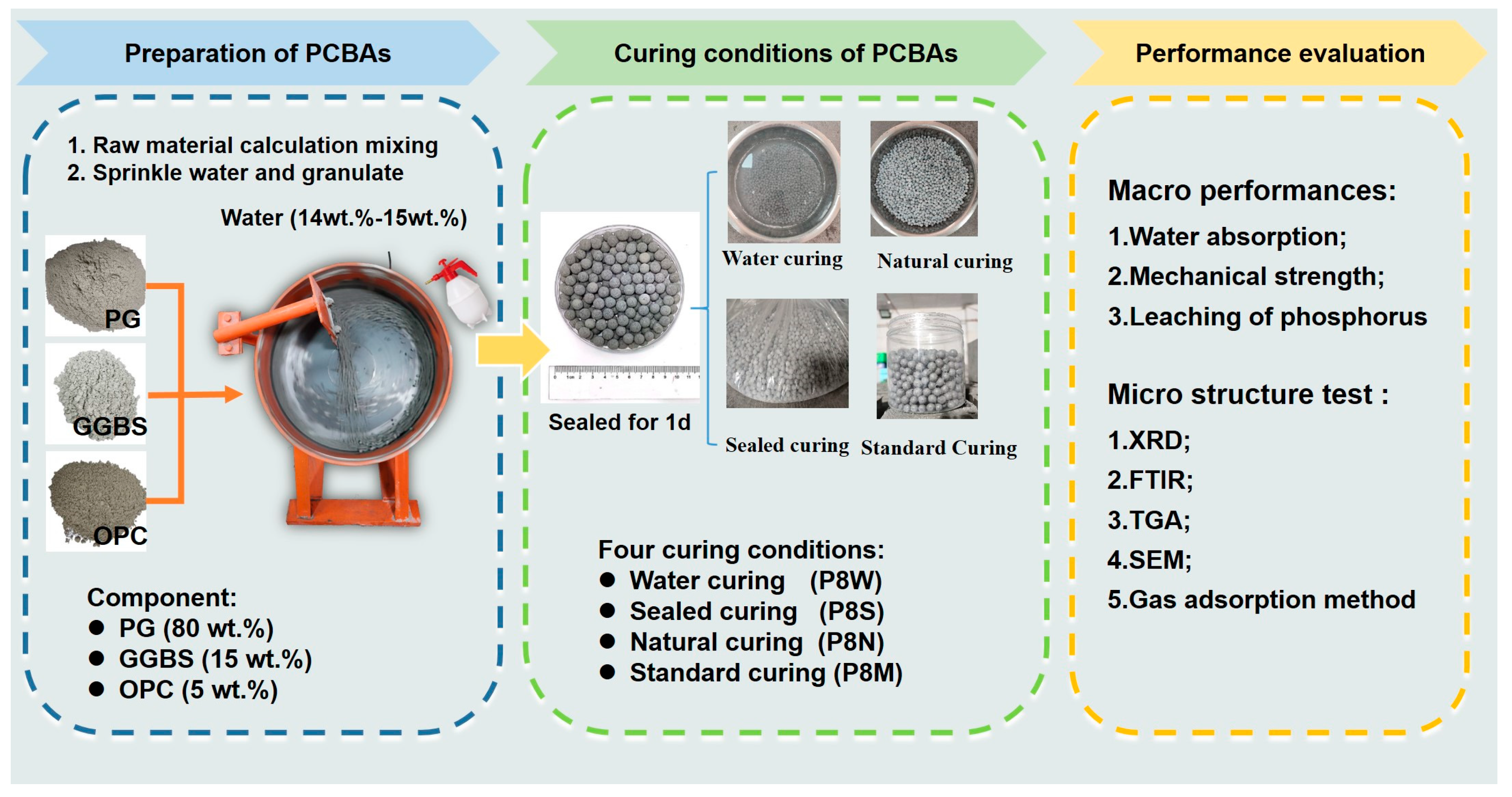

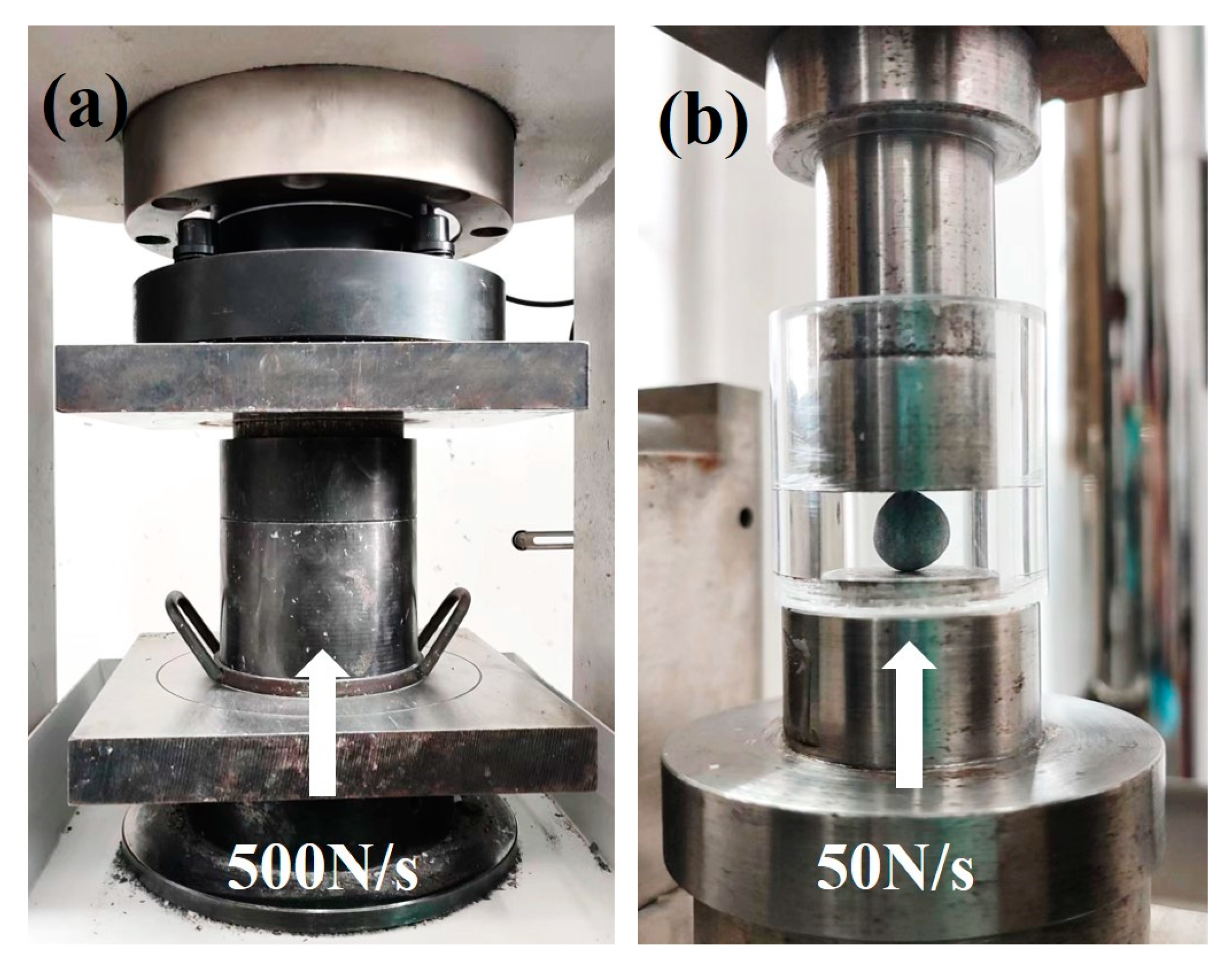
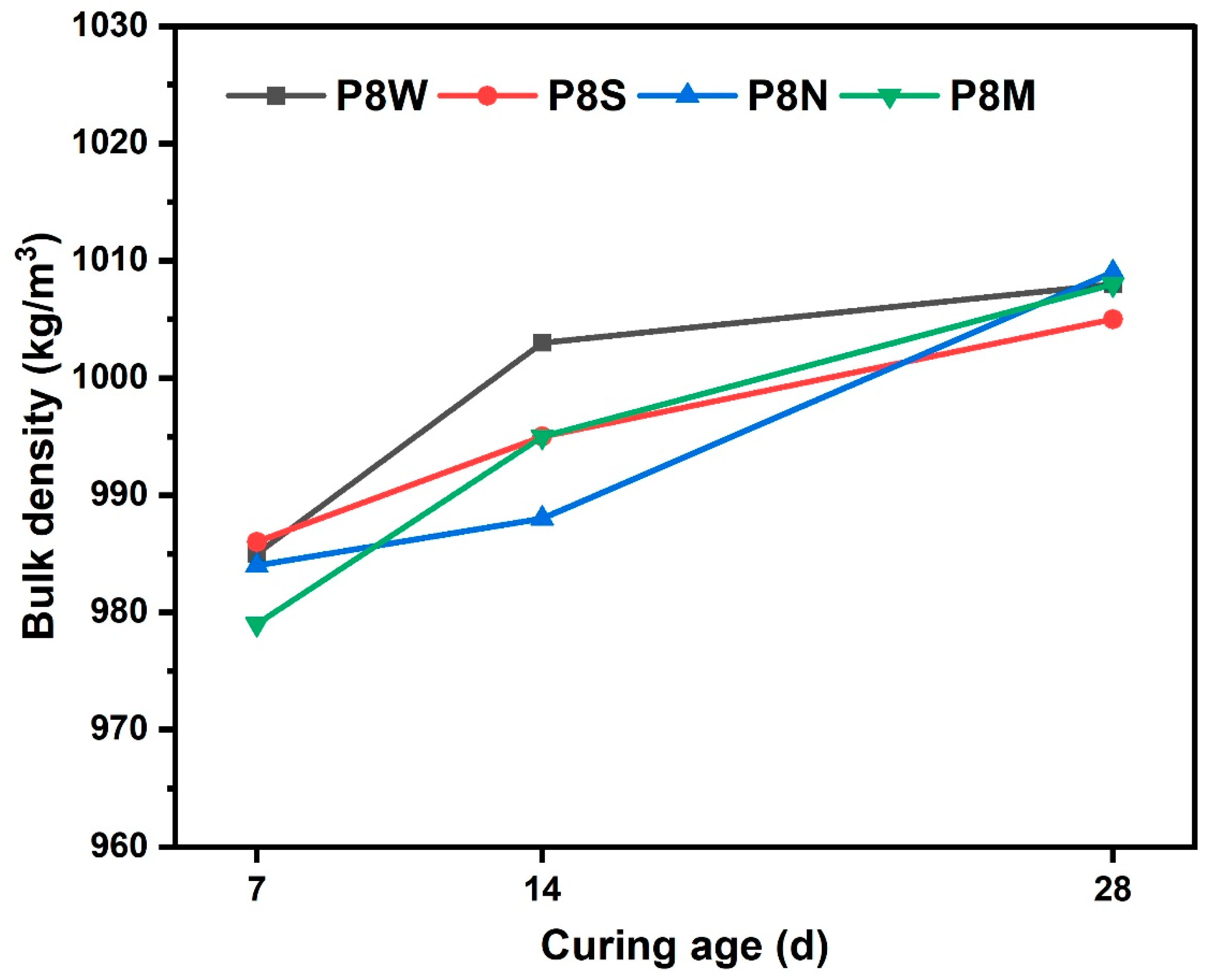
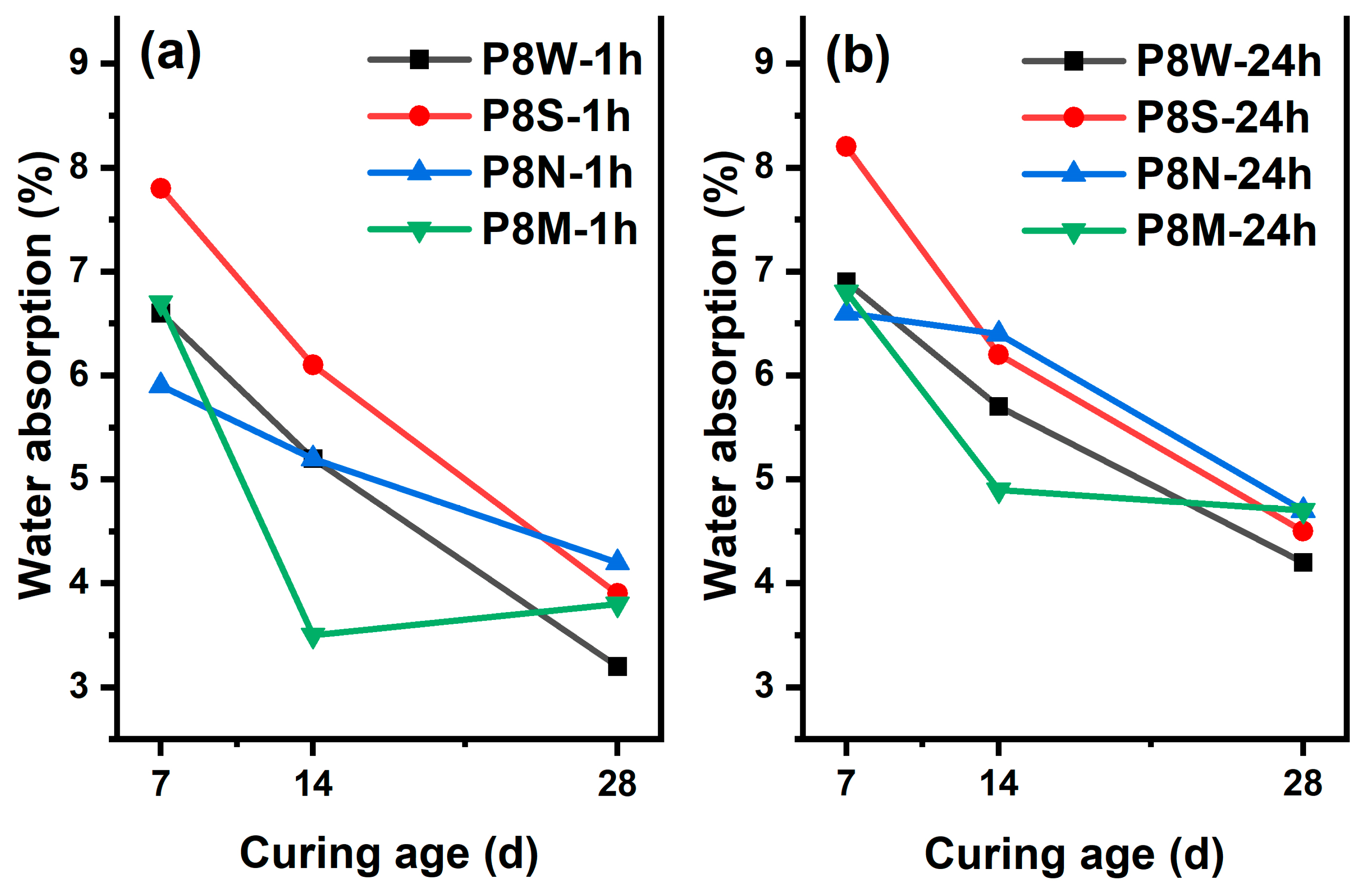

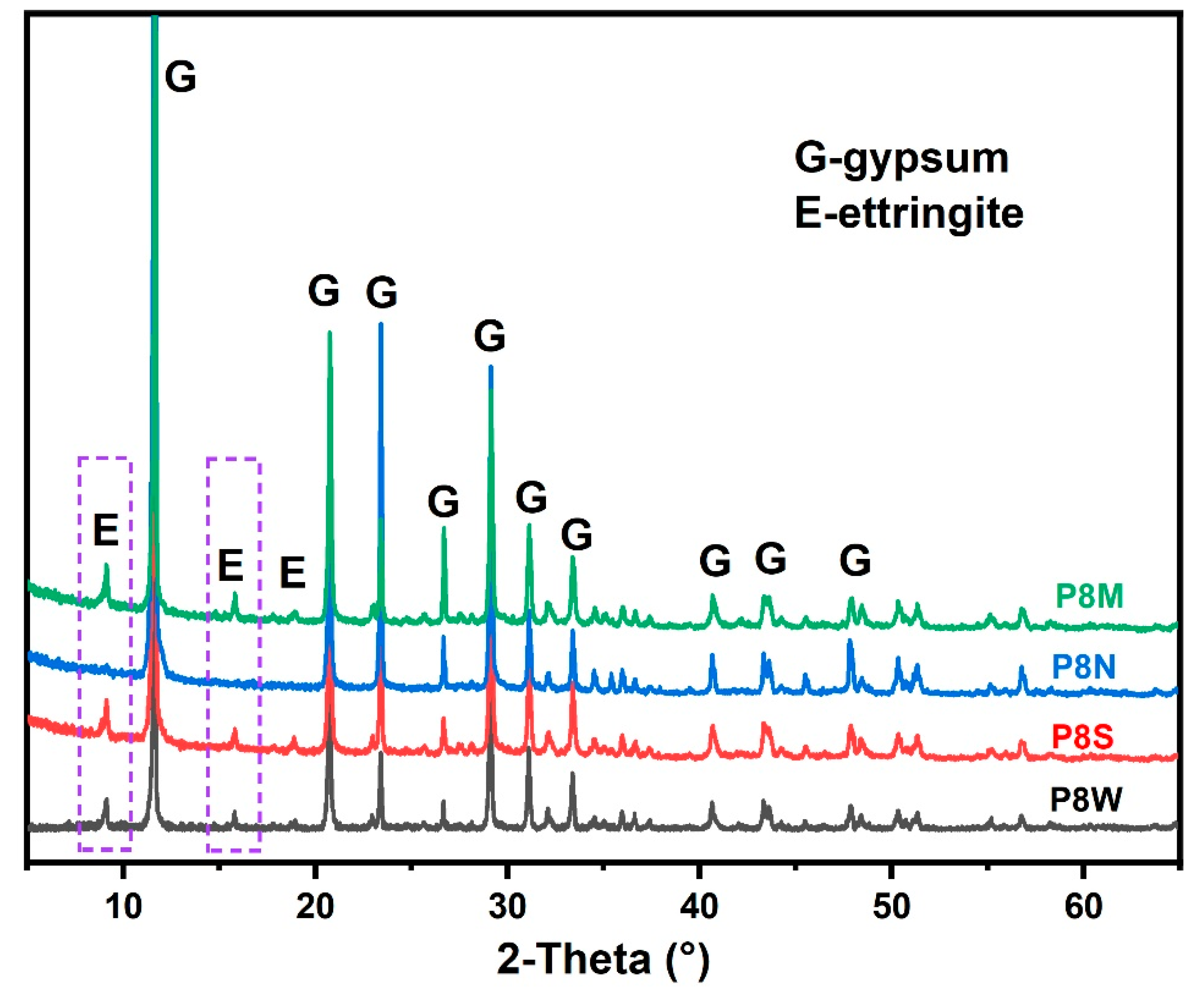
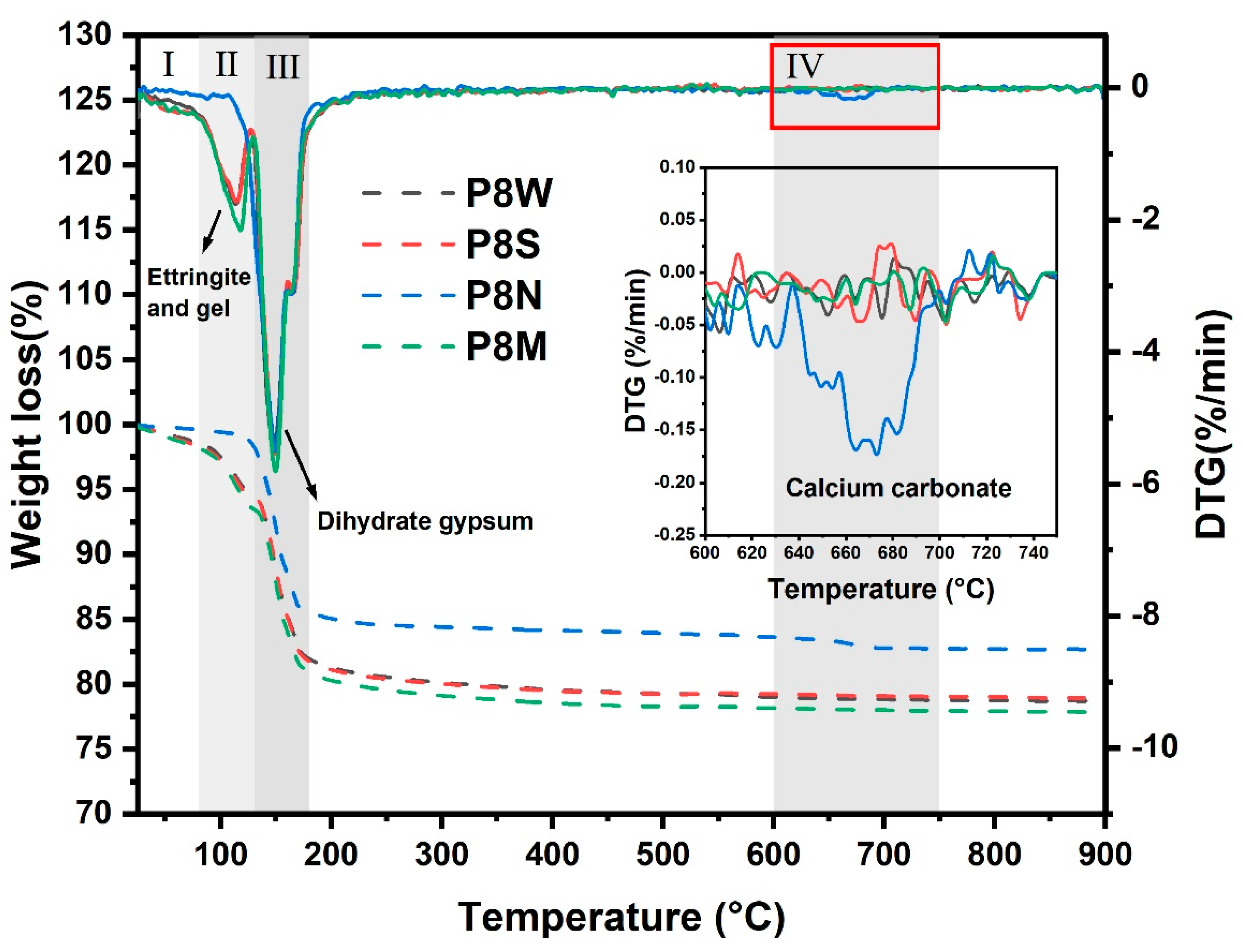


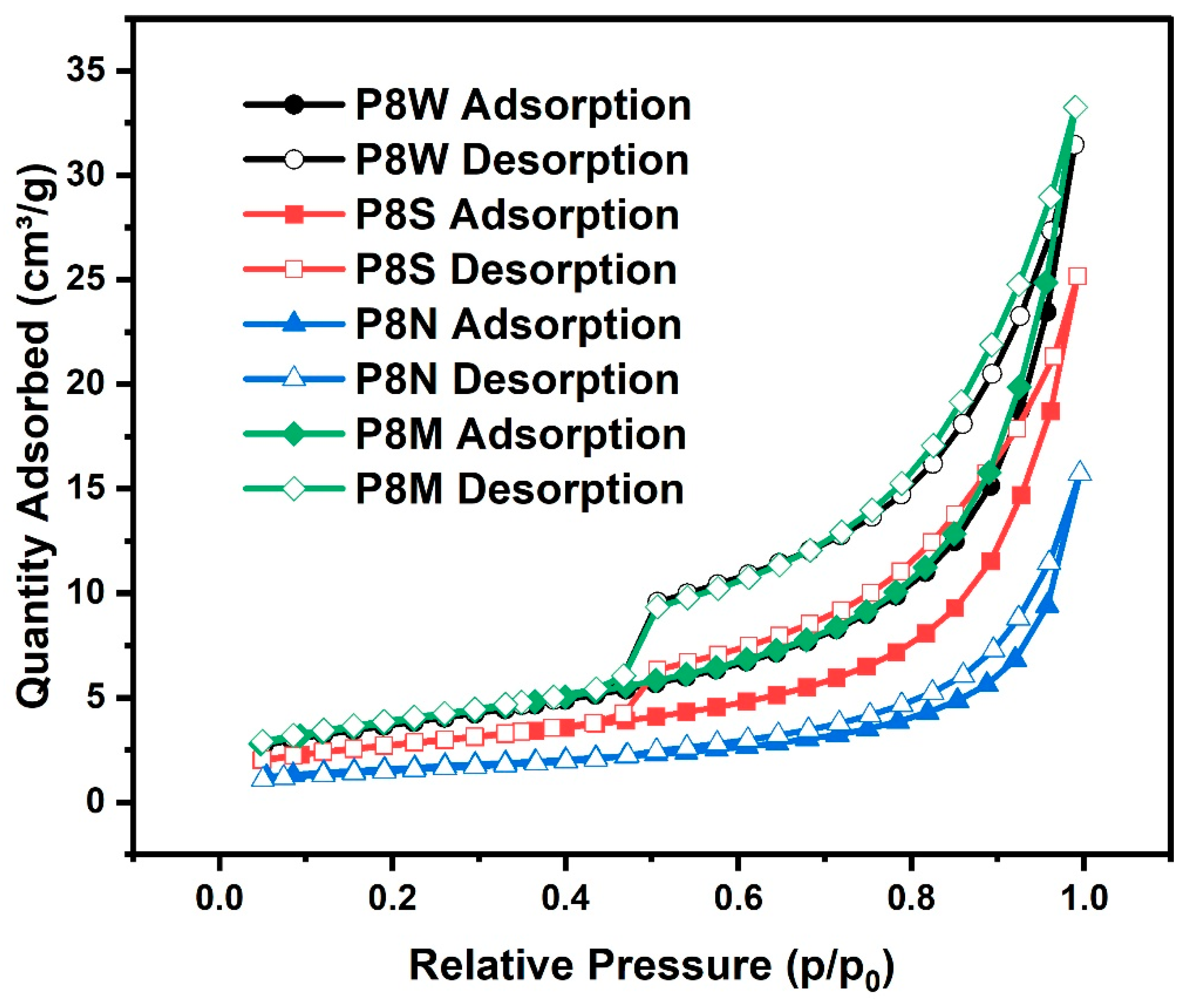

| Compositions (wt%) | PG | GGBS | Cement |
|---|---|---|---|
| SiO2 | 8.34 | 29.57 | 21.75 |
| Al2O3 | 1.27 | 14.02 | 6.45 |
| Fe2O3 | 0.58 | 1.39 | 3.24 |
| CaO | 26.66 | 41.27 | 58.02 |
| MgO | 0.11 | 8.24 | 2.25 |
| SO3 | 37.95 | 2.48 | 2.47 |
| TiO2 | 0.13 | 0.95 | 0.51 |
| P2O5 | 0.80 | 0.07 | 0.25 |
| MnO | / | 0.55 | / |
| F | 1.30 | / | / |
| LOI | 21.70 | 0.09 | 3.80 |
| Physical properties | |||
| Specific gravity | 2.28 | 2.84 | 2.98 |
| Specific surface area (m2/g) | 0.50 | 1.38 | 1.79 |
| D10 (μm) | 6.09 | 1.52 | 1.18 |
| D50 (μm) | 33.87 | 10.87 | 10.59 |
| D90 (μm) | 100.57 | 27.85 | 33.78 |
| Sample Label | Curing Condition | Relative Humidity | Temperature |
|---|---|---|---|
| P8W | Water curing | 100% | 20 ± 1 °C |
| P8S | Sealed curing | <5% | 20 ± 2 °C |
| P8N | Natural curing | >50% | 20 ± 2 °C |
| P8M | Standard (moist) curing | >90% | 20 ± 2 °C |
| Sample Label | Cylinder Compressive Strength (Dry Status)/MPa | Cylinder Compressive Strength (Saturated Surface Dry Status)/MPa | Softening Coefficient |
|---|---|---|---|
| P8W | 11.3 | 10.1 | 0.89 |
| P8S | 8.6 | 7.5 | 0.87 |
| P8M | 10.1 | 8.8 | 0.87 |
| P8N | 7.2 | 6.2 | 0.86 |
| Sample Label | Total Weight Loss (%) | Water in Dihydrate Gypsum (%) | Carbonates Content (%) | Water in Hydrations (%) |
|---|---|---|---|---|
| P8W | 21.184 | 17.737 | None | 3.447 |
| P8S | 20.926 | 17.794 | None | 3.132 |
| P8M | 22.020 | 17.549 | None | 4.471 |
| P8N | 17.243 | 15.980 | 2.818 | None |
| Wavenumbers (cm−1) | Bands |
|---|---|
| 525 | Si-O out-of-plane bending vibration (δSi-O) [53] |
| 605, 670 | S-O bending vibration [54] |
| 875–878 | CO32− out-of-plane bending vibration (v2) [55] |
| 925 | Si-O symmetry stretching vibration (v3) [53,56] |
| 970 | Si-O stretching vibration of Q2 (C-S-H) [57] |
| 1003 | Si-O stretching vibration of Q3 (C-S-H) [50] |
| 1090 | Si-O bending vibration in Q3 [52] |
| 1100–1200 | S-O symmetry stretching vibration of SO4 (v3) [54] |
| 1417, 1470 | C-O symmetry stretching vibration [52,56,58] |
| 1685, 1624 | H-O-H bending vibration [59] |
| 3408 | H-O-H stretching vibration [60] |
| 3550–3554 | H-O-H stretching vibration in gypsum [23] |
| Sample | SBET (m2/g) | Pore Volume (cm3/g) | Average Pore Size (nm) | Most Frequent Pore Diameter (nm) |
|---|---|---|---|---|
| P8W | 13.38 | 0.0486 | 8.5 | 6.0 |
| P8S | 9.78 | 0.0230 | 9.5 | 9.5 |
| P8M | 13.83 | 0.0513 | 8.9 | 8.9 |
| P8N | 5.66 | 0.0240 | 15.8 | 8.0 |
| Sample | Acetic Acid Leaching (mg/L) | Static Leaching (mg/L) |
|---|---|---|
| PG | 128.997 | 4.570 |
| P8W | 0.365 | 0.016 |
| P8S | 0.247 | 0.020 |
| P8N | 0.029 | 0.020 |
| P8M | 0.082 | 0.016 |
Disclaimer/Publisher’s Note: The statements, opinions and data contained in all publications are solely those of the individual author(s) and contributor(s) and not of MDPI and/or the editor(s). MDPI and/or the editor(s) disclaim responsibility for any injury to people or property resulting from any ideas, methods, instructions or products referred to in the content. |
© 2024 by the authors. Licensee MDPI, Basel, Switzerland. This article is an open access article distributed under the terms and conditions of the Creative Commons Attribution (CC BY) license (https://creativecommons.org/licenses/by/4.0/).
Share and Cite
Wang, G.; Ye, Z.; Sun, T.; Mo, Z.; Wang, Z.; Ouyang, G.; He, J.; Deng, Y. Comparison of Curing Conditions on Physical Properties, Mechanical Strength Development, and Pore Structures of Phosphogypsum-Based Cold-Bonded Aggregates. Materials 2024, 17, 4971. https://doi.org/10.3390/ma17204971
Wang G, Ye Z, Sun T, Mo Z, Wang Z, Ouyang G, He J, Deng Y. Comparison of Curing Conditions on Physical Properties, Mechanical Strength Development, and Pore Structures of Phosphogypsum-Based Cold-Bonded Aggregates. Materials. 2024; 17(20):4971. https://doi.org/10.3390/ma17204971
Chicago/Turabian StyleWang, Guiming, Zhiyi Ye, Tao Sun, Zhenlin Mo, Ziyan Wang, Gaoshang Ouyang, Juntu He, and Yihua Deng. 2024. "Comparison of Curing Conditions on Physical Properties, Mechanical Strength Development, and Pore Structures of Phosphogypsum-Based Cold-Bonded Aggregates" Materials 17, no. 20: 4971. https://doi.org/10.3390/ma17204971







